248 Bulldog-Mastiffs
THE ADVANCE OF THE PUGMASTIFFS
by David Hancock
 These are momentous days in the breed of Bullmastiff, with record numbers being registered and entered for shows. This could be good news but it could also spell ruin for an eternally unglamorous but hitherto unspoiled breed, which always seems to attract worthy people around the ring. The stories of breeds of dog being ruined by popularity are legion. The pitfalls identified in the downfall of other breeds quite often tell a similar story: quantity driving out quality, a significant loss of type, a lower standard of judging by specialists, position-seeking club officials creating ill-feeling, bad sportsmanship and rosette-chasing money-grabbing individuals coming to the fore. Every breed relies on a spine of honourable people who really care about the breed and its best interests; are they paramount in the breed of Bullmastiff?
These are momentous days in the breed of Bullmastiff, with record numbers being registered and entered for shows. This could be good news but it could also spell ruin for an eternally unglamorous but hitherto unspoiled breed, which always seems to attract worthy people around the ring. The stories of breeds of dog being ruined by popularity are legion. The pitfalls identified in the downfall of other breeds quite often tell a similar story: quantity driving out quality, a significant loss of type, a lower standard of judging by specialists, position-seeking club officials creating ill-feeling, bad sportsmanship and rosette-chasing money-grabbing individuals coming to the fore. Every breed relies on a spine of honourable people who really care about the breed and its best interests; are they paramount in the breed of Bullmastiff?
The most visual aspect, and potentially most damaging  feature in the breed is the lack of uniform type. Just about every other pedigree breed has a standard appearance, with members of the breed looking like the others at first glance. Chows, Pharoah Hounds, Deerhounds, Border Terriers, Beagles, Bloodhounds, Poodles, Dachshunds, Bullterriers, Collies, you name the breed and a clear mental picture of the breed's phenotype, its physical 'signature', comes to mind. This is not so in Bullmastiffs. It is becoming rare to find two heads the same in the same show ring. True type may be a matter of subjective judgement in any breed, but in Bullmastiffs there simply isn't a model for the breed, just conflicting concepts.
feature in the breed is the lack of uniform type. Just about every other pedigree breed has a standard appearance, with members of the breed looking like the others at first glance. Chows, Pharoah Hounds, Deerhounds, Border Terriers, Beagles, Bloodhounds, Poodles, Dachshunds, Bullterriers, Collies, you name the breed and a clear mental picture of the breed's phenotype, its physical 'signature', comes to mind. This is not so in Bullmastiffs. It is becoming rare to find two heads the same in the same show ring. True type may be a matter of subjective judgement in any breed, but in Bullmastiffs there simply isn't a model for the breed, just conflicting concepts.
There is one school of thought which sees the Bullmastiff as more Mastifflike than the breed standard defines. There is another which visualises the breed as huge Bulldogs. Then there is what might be termed the German school, which can be summed up in the phrase allegedly used by a prominent German fancier: 'the bigger -- the better'. This latter 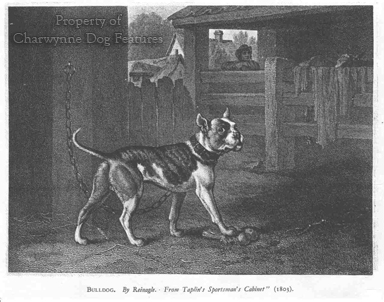 view is contradicted by the breed standard, but disappointingly is supported even by some breed specialist judges. All three views lead to one highly undesirable feature: coarse dogs.
view is contradicted by the breed standard, but disappointingly is supported even by some breed specialist judges. All three views lead to one highly undesirable feature: coarse dogs.
Breeds of dog which cannot consistently produce smooth lines of physical appearance do not breed true to type. The early Bulldog breeders realised this and soon acknowledged its penalties. Breeds like the Rhodesian Ridgeback, the Dobermann and the Dogo Argentino, manufactured breeds with more ingredients than the Bullmastiff, now breed more true to type and are rarely coarsely constructed. The Boxer illustrates the fact that a breed can come from a broad-mouthed origin and not be coarse-headed.
Just as bad as being coarse in the head is coarseness in the shoulders. Far too many Bullmastiffs display ugly shoulders, lacking symmetry. For a breed to possess these two features so regularly after seventy years as a recognised pedigree breed on the Kennel Club's lists is unprecedented. What have Bullmastiff breeders been doing in that time? And that is an honest enquiry not a snide comment. So many of the early registrations in the breed lacked this awful coarseness. Where is the logic in extolling the virtues of outstanding dogs of the distant past and t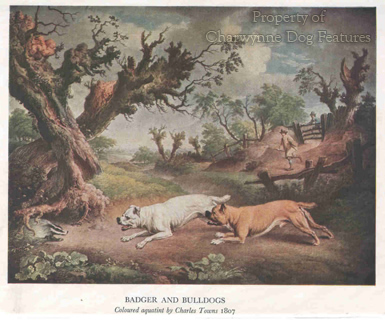 hen producing dogs in the same breed which look nothing like them?
hen producing dogs in the same breed which look nothing like them?
If you look at the winning dogs at successive world shows, it is becoming apparent that if this trend continues then the breed will have to be renamed 'Pugmastiffs', for that is what these winning dogs were. Overwrinkled, loose-lipped, massively-boned, heavy-headed, coarse in construction and with no trace of the symmetry required by the breed standard, it is sad to see such wholly undesirable features being rewarded in such a highly visible arena. Veterinary surgeons constantly warn us of the health problems caused by excessively wrinkled skin, too much bone and too wide a jaw. This apart, what is the value of a breed standard if judges ignore it?
The wording of the Bullmastiff breed standard sets out the blueprint for type. This wording could always be improved but its message cannot be ignored. This standard uses these descriptive words to guide breeders and judges: "Symmetrical...fair wrinkle when interested but not when in repose...flews not pendulous...shoulders not overloaded...hindlegs not cumbersome...movement indicates power...hindlegs denoting a balanced and harmonious movement." The expression 'not cumbersome' is used twice in the breed standard, initially under general appearance. On such words should the breed be bred and judged. But what do we find? Winning dogs featuring over-large heads, permanently wrinkled forefaces, coarse shoulders, cumbersome gait, pendulous flews 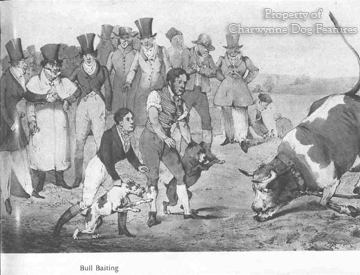 and a lack of power on the move. One recent champion would win in a Neapolitan Mastiff ring!
and a lack of power on the move. One recent champion would win in a Neapolitan Mastiff ring!
Type and health are the two most important issues in any breed if the future of the breed is in safe hands. If type was being sacrificed to health I could understand the temporary priority. But disturbingly this is not true. The incidence of lymphosarcoma in the breed is very worrying but there is not one scheme to trace the carriers through pedigrees or take steps to combat such a killer. Only 400-odd Bullmastiffs have ever been hip-scored and the results are frightening, producing a high average score even from those dogs whose owners are responsible enough to have their dogs assessed. Every month or so I hear of horror stories of puppies in the breed being sold with crank tails, cleft palate and hare lips or of adult dogs with cruciate ligament, dental, eye, skin, hip and blood disorders. What have the breed clubs been doing for the past thirty years or so? One breed columnist has been campaigning for such action for about that span of time but with no response.
Newcomers to the breed are all too frequently being sold unsound pups, sometimes from long-established kennels. When distressed purchasers do go back to such breeders, they are met with rudeness, hostility and non-cooperation.  One prospective puppy-purchaser was told, on questioning the pup's tongue protruding out of a closed mouth, "Oh, he'll grow into that tongue." The purchaser later discovered that this breeder was breeding a wry-mouthed sire to a wry-mouthed dam, as though jaw construction didn't matter at all. Of course such things happen in other breeds but what kind of solace is that? Of course there are plenty of honest breeders in the breed, but where is the code of ethics in the breed? Such a code is even more important when a breed becomes popular.
One prospective puppy-purchaser was told, on questioning the pup's tongue protruding out of a closed mouth, "Oh, he'll grow into that tongue." The purchaser later discovered that this breeder was breeding a wry-mouthed sire to a wry-mouthed dam, as though jaw construction didn't matter at all. Of course such things happen in other breeds but what kind of solace is that? Of course there are plenty of honest breeders in the breed, but where is the code of ethics in the breed? Such a code is even more important when a breed becomes popular.
Bullmastiffs are formidable looking dogs with immense physical power. Bred unwisely and allowed to become dominant, such dogs can be a menace. We have already had dramatic descriptions in the national newspapers of children being bitten by wayward Bullmastiffs, thankfully only a few, but one drawing a leading article in The Sunday Times disparaging the breed. Shortly after the last case, I saw a Bullmastiff attempt to bite the judge in the ring at a breed show. This dog, despite being a fine looking specimen, was well known in the breed for its suspect temperament. Now the breed's reputation is being tarnished by a dog being deregistered. It was an accident waiting to 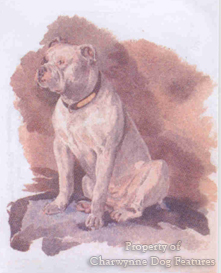 happen. Why didn't the breed elders step forward and prevent such a wholly undesirable incident from occuring? Is there really no one of sufficient stature in the breed to do this?
happen. Why didn't the breed elders step forward and prevent such a wholly undesirable incident from occuring? Is there really no one of sufficient stature in the breed to do this?
From this background of lost type, physical and mental unsoundness and irresponsible breeders, we now have the worst possible accompaniment: the overproduction of puppies. It is a recipe for disaster in the breed. It is not unusual to see five litters of Bullmastiffs being advertised in the weekly Exchange and Mart, nearly always from registered stock. How long will some of them live? What harm will they do to the breed whilst they are alive? When the Kennel Club will register anything with four legs and two ears and aren't interested in quality control, action to curb such activities is never easy. That doesn't mean that nothing can be done; single-issue lobbyists are more successful nowadays than big companies.
A close examination of the breeding of even some champion-status Bullmastiffs leaves one wondering whether to laugh or cry. One recent champion has 59 different ancestors out of 62 on a five-generation pedigree. Whatever happened to line-breeding? 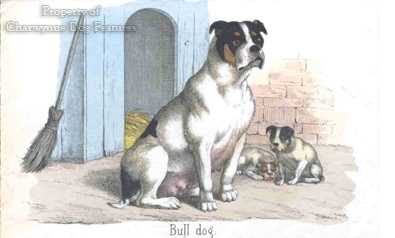 This dog is extensively used at stud; how can a sire from such a mixed background throw consistently good offspring? How can any experienced breeder take such a risk with a precious bitch? The bitch that died of shock last year immediately following a forced mating should stir all our consciences. A newcomer to the breed, enthusiastic and eager to learn, received such conflicting advice on breeding that he shook his head and went off to another breed -- in time to attend a breed seminar, on breeding better dogs.
This dog is extensively used at stud; how can a sire from such a mixed background throw consistently good offspring? How can any experienced breeder take such a risk with a precious bitch? The bitch that died of shock last year immediately following a forced mating should stir all our consciences. A newcomer to the breed, enthusiastic and eager to learn, received such conflicting advice on breeding that he shook his head and went off to another breed -- in time to attend a breed seminar, on breeding better dogs.
This is a magnificent breed, one I have admired since seeing them at the Bath Dog Show in the late 1940s. I really enjoy the character of my two, but they have cost me more in vet's bills than all my previous dogs put together. Yet they are fitter than most of the exhibits I see at shows. Obtaining good movement is a problem in the breed, but so  many exhibits are soft-muscled or overweight -- and they win! Where is the breed heading? Is it in good hands? At a breed show earlier this year, a well known breeder told me that my recent book on the breed was 'full of mistakes' and gave me guidance on what needed correcting. I researched her statements; all were untrue and she must have known that. What can be the motivation of such a person?
many exhibits are soft-muscled or overweight -- and they win! Where is the breed heading? Is it in good hands? At a breed show earlier this year, a well known breeder told me that my recent book on the breed was 'full of mistakes' and gave me guidance on what needed correcting. I researched her statements; all were untrue and she must have known that. What can be the motivation of such a person?
It is time for those in the breed who are truthful, honourable and really knowledgeable to act collectively. The alternative is awesome. The Pugmastiff will replace the Bullmastiff. Unsound dogs will be produced in great quantities, leading to breeders being sued (the precedents are now in place) and dogs misbehaving, with literally tragic consequences. The quite splendid breed of Bullmastiff is under threat but more perhaps from apathy than evil. Both can spell death to a breed. Do those who say they care about the breed truly care? Do they care enough to stop the rot? It takes just one good man to stay silent to allow a less good man to succeed. In the meantime, promote the Pugmastiff if that's your preference, but, please, not in the Bullmastiff rings!
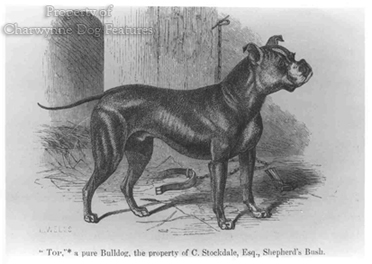 |
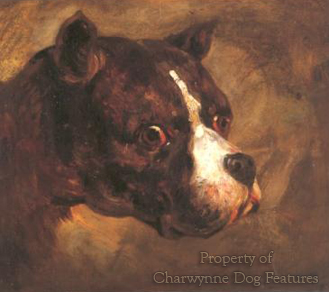 |
|
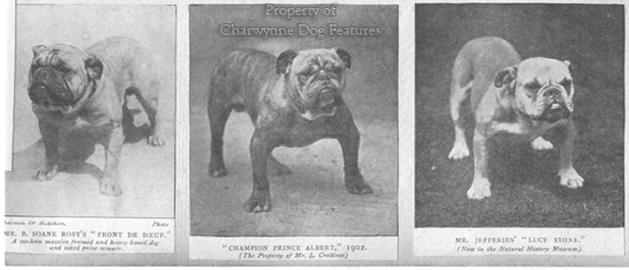 |
||